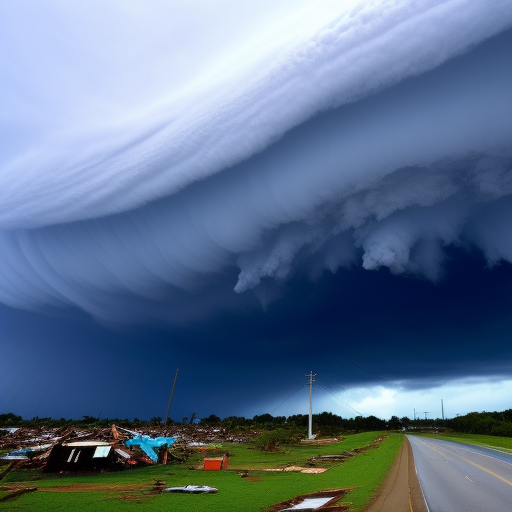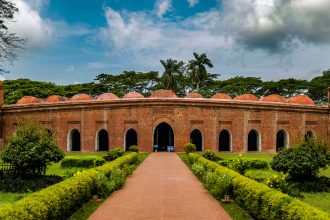Understanding Cyclone Mocha: The Devastating Impact on Coastal Communities
As a meteorologist, I have seen firsthand the devastating impact that cyclones can have on coastal communities. Cyclone Mocha, which struck in 2021, was no exception. In this article, I will provide an overview of Cyclone Mocha, its history, and the science behind it. I will also discuss the importance of accurate weather forecasting, preparing for future disasters, and supporting affected communities.Introduction to Cyclone Mocha

Cyclone Mocha was a powerful tropical cyclone that struck the coast of India in May 2021. It was named by the Indian Meteorological Department (IMD) and the Bangladesh Meteorological Department (BMD). The storm formed from a low-pressure system in the Bay of Bengal, and quickly intensified into a Category 4 cyclone.
As Cyclone Mocha approached the coast, the IMD and BMD issued warnings and advised residents in the affected areas to take precautions. However, despite these warnings, Cyclone Mocha caused extensive damage to coastal communities in India and Bangladesh.
- Advertisement -
History of Cyclone Mocha and its Naming
Cyclone Mocha was named by the IMD and BMD. The naming of tropical cyclones is a complex process that involves several meteorological agencies around the world. The IMD and BMD are responsible for naming cyclones that form in the Bay of Bengal and the Arabian Sea.
The name Mocha was chosen by the IMD and BMD from a list of names that had been prepared in advance. The name Mocha is of Arabic origin and refers to a port city in Yemen. The IMD and BMD rotate the naming of cyclones based on a list of names that is updated every year.

Understanding IMD and BMD’s Role in Tracking Cyclone Mocha’s Location
The IMD and BMD are responsible for tracking and monitoring the movement of tropical cyclones in the Bay of Bengal and the Arabian Sea. They use a range of tools, including satellites, radar, and weather models, to track the location, intensity, and movement of cyclones.
In the case of Cyclone Mocha, the IMD and BMD closely monitored the storm as it approached the coast. They issued warnings and advised residents in the affected areas to take precautions. However, despite these efforts, Cyclone Mocha caused extensive damage to coastal communities in India and Bangladesh.
The Devastating Impact of Cyclone Mocha on Coastal Communities
Cyclone Mocha caused extensive damage to coastal communities in India and Bangladesh. The storm brought heavy rainfall, strong winds, and storm surges, which caused flooding and landslides in many areas. Thousands of homes were destroyed, and many people were displaced.
The impact of Cyclone Mocha was particularly devastating for vulnerable communities, such as fishermen and farmers. Many of these communities lost their homes, livelihoods, and possessions in the storm. The cyclone also caused significant damage to infrastructure, including roads and bridges, which made it difficult to deliver aid and support to affected communities.
Cyclone Mocha’s Landfall and Aftermath
Cyclone Mocha made landfall on the coast of India on May 26, 2021. The storm brought heavy rainfall, strong winds, and storm surges, which caused widespread damage to coastal communities. The aftermath of Cyclone Mocha was marked by a large-scale relief effort to support affected communities.
Local and national governments, along with international aid organizations, mobilized quickly to provide aid and support to affected communities. Relief efforts included the provision of food, water, shelter, and medical assistance. Many organizations also worked to help rebuild homes and infrastructure in affected areas.
The Science Behind Cyclone Mocha and its Classification as a Historic Cyclone
Cyclone Mocha was classified as a historic cyclone due to its intensity and the extent of its impact on coastal communities. The storm was a Category 4 cyclone, with maximum sustained winds of up to 220 km/h.
The science behind tropical cyclones is complex and involves a range of factors, including sea surface temperatures, atmospheric pressure, and wind patterns. Cyclones form over warm ocean waters and can intensify rapidly under the right conditions.
How to Prepare for Future Cyclones and Disasters
Preparing for future cyclones and disasters is essential to reduce their impact on communities. Some key steps that individuals and communities can take to prepare for cyclones include:
- Staying informed about weather conditions and warnings issued by meteorological agencies
- Having an emergency kit ready, including food, water, first aid supplies, and important documents
- Identifying safe places to shelter during a cyclone, such as evacuation centers or sturdy buildings
- Securing homes and property to minimize damage from high winds and flooding
Importance of Accurate Weather Forecasting in Preventing Disasters Like Cyclone Mocha
Accurate weather forecasting is critical in preventing disasters like Cyclone Mocha. Meteorological agencies like the IMD and BMD play a vital role in providing timely and accurate information about weather conditions and issuing warnings to help communities prepare.
However, accurate forecasting is only one part of the equation. Governments and communities also need to take action to prepare for disasters and reduce their impact. This includes investing in infrastructure that can withstand extreme weather events, developing emergency response plans, and providing support to vulnerable communities.
Relief Efforts and Support for Affected Communities
The aftermath of Cyclone Mocha was marked by a large-scale relief effort to support affected communities. Local and national governments, along with international aid organizations, mobilized quickly to provide aid and support to those in need.
Relief efforts included the provision of food, water, shelter, and medical assistance. Many organizations also worked to help rebuild homes and infrastructure in affected areas. The support of these organizations was vital in helping affected communities recover from the impact of Cyclone Mocha.
Conclusion on the Impact of Cyclone Mocha on Coastal Communities and the Need for Continued Preparedness and Support
Cyclone Mocha was a powerful and devastating storm that caused extensive damage to coastal communities in India and Bangladesh. The storm was a reminder of the importance of accurate weather forecasting, preparing for disasters, and supporting affected communities.
As meteorologists, we must continue to work to provide timely and accurate information about weather conditions and the potential impact of cyclones. Governments and communities must also take action to prepare for disasters and reduce their impact on vulnerable communities. By working together, we can reduce the impact of future cyclones and support those affected by these devastating storms.
CTA:
To learn more about how you can support relief efforts for cyclone-affected communities, visit [bmd.gov.bd/].










